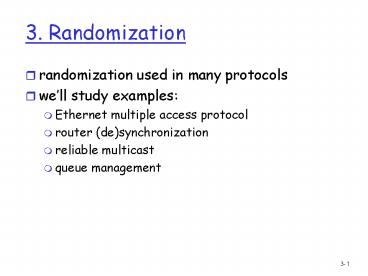3. Randomization - PowerPoint PPT Presentation
Title:
3. Randomization
Description:
only one node can send successfully at a time ... value of K when we were succesful (analogy: TCP remembers last values of congestion window size) ... – PowerPoint PPT presentation
Number of Views:14
Avg rating:3.0/5.0
Title: 3. Randomization
1
3. Randomization
- randomization used in many protocols
- well study examples
- Ethernet multiple access protocol
- router (de)synchronization
- reliable multicast
- queue management
2
Ethernet
- single shared broadcast channel
- 2 simultaneous transmissions by nodes
interference - only one node can send successfully at a time
- multiple access protocol distributed algorithm
that determines how nodes share channel, i.e.,
determine when node can transmit
Metcalfes Ethernet sketch
3
Ethernet uses CSMA/CD
- A sense channel, if idle
- then
- transmit and monitor the channel
- If detect another transmission
- then
- abort and send jam signal
- update collisions
- delay as required by exponential backoff
algorithm - goto A
- else done with the frame set collisions to
zero - else wait until ongoing transmission is over and
goto A
4
Ethernets CSMA/CD (more)
- Jam Signal make sure all other transmitters are
aware of collision 48 bits - Exponential Backoff
- first collision for given packet choose K
randomly from 0,1 delay is K x 512 bit
transmission times - after second collision choose K randomly from
0,1,2,3 - after next collision double K (and keep doubling
on collisions until..) - after ten or more collisions, choose K randomly
from 0,1,2,3,4,,1023
5
Ethernets use of randomization
- resulting behavior probability of retransmission
attempt (equivalently length of randomization
interval) adapted to current load - simple, load-adaptive, multiple access
randomize retransmissions over longer time
interval, to reduce collision probability
heavier Load (most likely), more nodes trying to
send
more collisions
6
Ethernet comments
- upper bounding at 1023 k limits max size
- could remember last value of K when we were
succesful (analogy TCP remembers last values of
congestion window size) - Q why use binary backoff rather than something
more sophisticated such as AIMD simplicity - note ethernet does multiplicative-increase-comple
te-decrease (why?)
7
Analyzing the CSMA/CD Protocol
- Goal quantitative understanding of performance
of CSMA protocol - fixed length pkts
- pkt transmission time is unit of time
- throughput S - number of pkts successfully
(without collision) transmitted per unit time - a end-to-end propagation time
- time during which collisions can occur
8
- offered load G - number pkt transmissions
attempted per unit time - note SltG, but S depends on G
- Poisson model probability of k pkt transmission
attempts in t time units - Probk trans in t ((Gt)k
)(e-Gt)/k! - infinite population model
- capacity of multiple access protocol maximum
value of S over all values of G
9
Analyzing CSMA/CD(cont)
- Focus on one transmission attempt
- S exp(- a G) /(1/Gexp(- a G)(1 a)1.5 a)
10
a .01
a .02
a .05
a .10
11
The bottom line
- Why does ethernet use randomization to
desynchronize a distributed adaptive algorithm
to spread out load over time when there is
contention for multiple access channel































